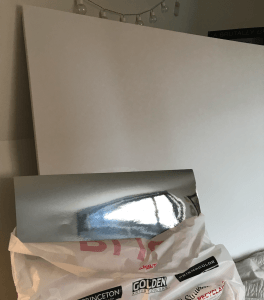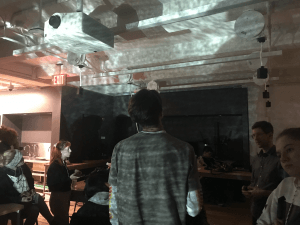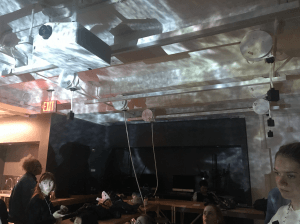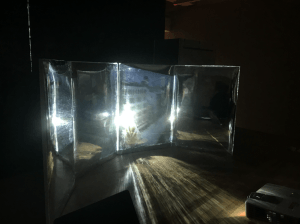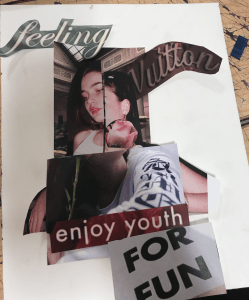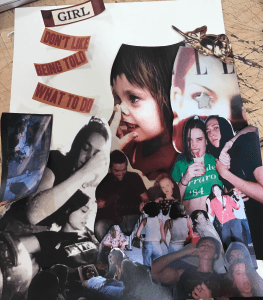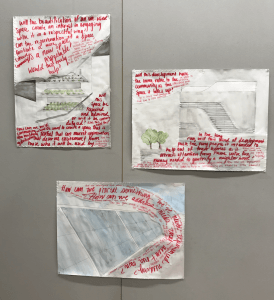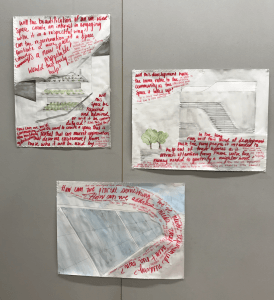At the beginning of the semester, a seventeen year old fresh out of high school, I was perhaps less prepared than she anticipated for the responsibilities she would be taking on. I quickly saw myself realize that while I was able to do well in high school classes with minimal effort, the expectations of college were much higher and required the use of my full motivation and hard work. The workload was almost immediately overwhelming, causing me to sometimes finish projects last minute and with little thought. This was disheartening, as I came to the school to put my best work forth and get as much out of my classes as possible. However, as I got more and more used to the workload, I started to be able to get excited and involved with my projects and teachers. Not to mention I also started to be more on time, one of my bigger struggles at the beginning of the year. The projects became more to me than just busywork, and I began to dig deep into the curriculum and my work. It became less about the grade I received and more about the process of getting there and what I learned along the way. My projects throughout are each representations of different facets of my creative self, and represent my newfound excitement for my schoolwork. The end of the semester has been a culmination for everything I’ve learned and exemplifies the effort and care that I’ve begun to put into my work. This, more than any development of skill or precision, is the most valuable thing that I have learned this semester. While I’ve learned lots during the semester, there is absolutely still room for much growth in my future years of college.
- projects discuss my mother and explore how and why she has influenced myself and others through her career
- I hoped to emulate the paradigm through which she lives her life and her way of being through my project
- project was deeply inspired by this quote:
“My intention got very specific and when people were taking my picture I was trying to say, ” There are fewer rules than you think.” I wanted to express that things which you think are not possible can become possible if you just do them. I’m older now and I value and depend on boundaries often in my own life, but I still don’t respect arbitrary ones that are only there because nobody has bothered to ask why.”
The research paper for my seminar bridge project explains my mothers career as a young model and how she influenced the fashion industry and was able to maintain personal integrity in an industry that puts so much emphasis on superficiality. This part of Bridge 04 is less of a personal account and more of a factual tale of who my mother was as a young woman. The sound portrait takes more of a personal look at my mother and my relationship to her.
For the sound portrait I used a variety of mediums to embody my mother and the influence she’s has on my life and many others. The sound portion of this piece includes clips of her favorite songs, sounds that embody her energy and quotations of hers that I find inspiring. It also includes a song that she wrote around the time I was born. This sound portrait is deeply personal to me, and I hoped to communicate the ways in which my mother has shaped who I am. The visual portion utilizes a projected video of her younger self which is reflected through distorted mirrors onto the ceiling. This is meant to communicate the idea that I am a reflection of her and the paradigm through which she lives her life.
BRIDGE 1
first project, figuring out how to make a good composition and properly get my point across
MOVIE POSTER
first time experimenting with setting up a photoshoot for a project, figuring out makeup and costume.
Our movie poster combines both protographic and textural elements to portray the two main characters and our imagined new and horrific world. The poster reflects the style of the ‘90s, and projects a futuristic world where in cyborgs are indistinguishable from the human form. We have photographed both Puma and Sierra and merged their two faces together to create the distorted and grotesque image of a cyborg. The background of our poster is meant to frame our focal image and mimic the ideal visual of the void. The movie poster will appear in all black and white. Through this movie poster we aim to both terrify and provoke our audience to see our film.
GROUP PROJECT
We spent time reflecting on both our individual issues and the project prompt, as outlined
in the syllabus, to best approach this design challenge. The syllabus asks students to “imagine
a utopian place in which both of the issues you have identified have been solved”. The issues
we chose to tackle are the lack of access to public education and to healthy food, specifically in
low-income neighborhoods.
Initially we found ourselves looking at this project through the lense of a design
challenge which, in some ways, gave our work a stiff feeling – more architectural than artistic.
Our intention for this project was to create a multi-purpose space that aims to provide both
access to public education and create a sustainable source of organic produce for residents of
the Bronx – a real neighborhood, right here in New York City, which currently faces both of
these issues. Moving forward, our hope for this project became not only to create said utopian
space, but to use our platform as artists to start to examine the implications of our utopia. Where
were their dichotomies between our intentions in designing our facility and the reality of its
effects on the community it was meant to serve?
A utopia can be defined in two ways. The Google Dictionary defines a utopia as “an
imagined place or state of things in which everything is perfect.” Merriam Webster, on the other
hand, defines utopias as “an impractical scheme for social improvement.” Which is ours? Does it
exist in a space between the two? These were questions we felt we could not fully answer – and
we thought it would be important to reflect our uncertainty in our completed project.
Our final composition consists of three sets of overlayed of twin-visuals, each meant to
address both of these distinct definitions of utopia. The base layers of these layered visuals are
architectural sketches of prominent details in our design. These beautified sketches present an
image of efficiency and innovation. In these sketches everything is perfect. The top layer,
however, takes a more skeptical look at our facility: layers of tracing paper sewn over the base
sketches expose our doubts and concerns; it begs to ask the hard questions whether our
attempt to aid a community as outsiders will simply become a means through which it is
gentrified and displaced in the long run.
importance of self-criticism in work
